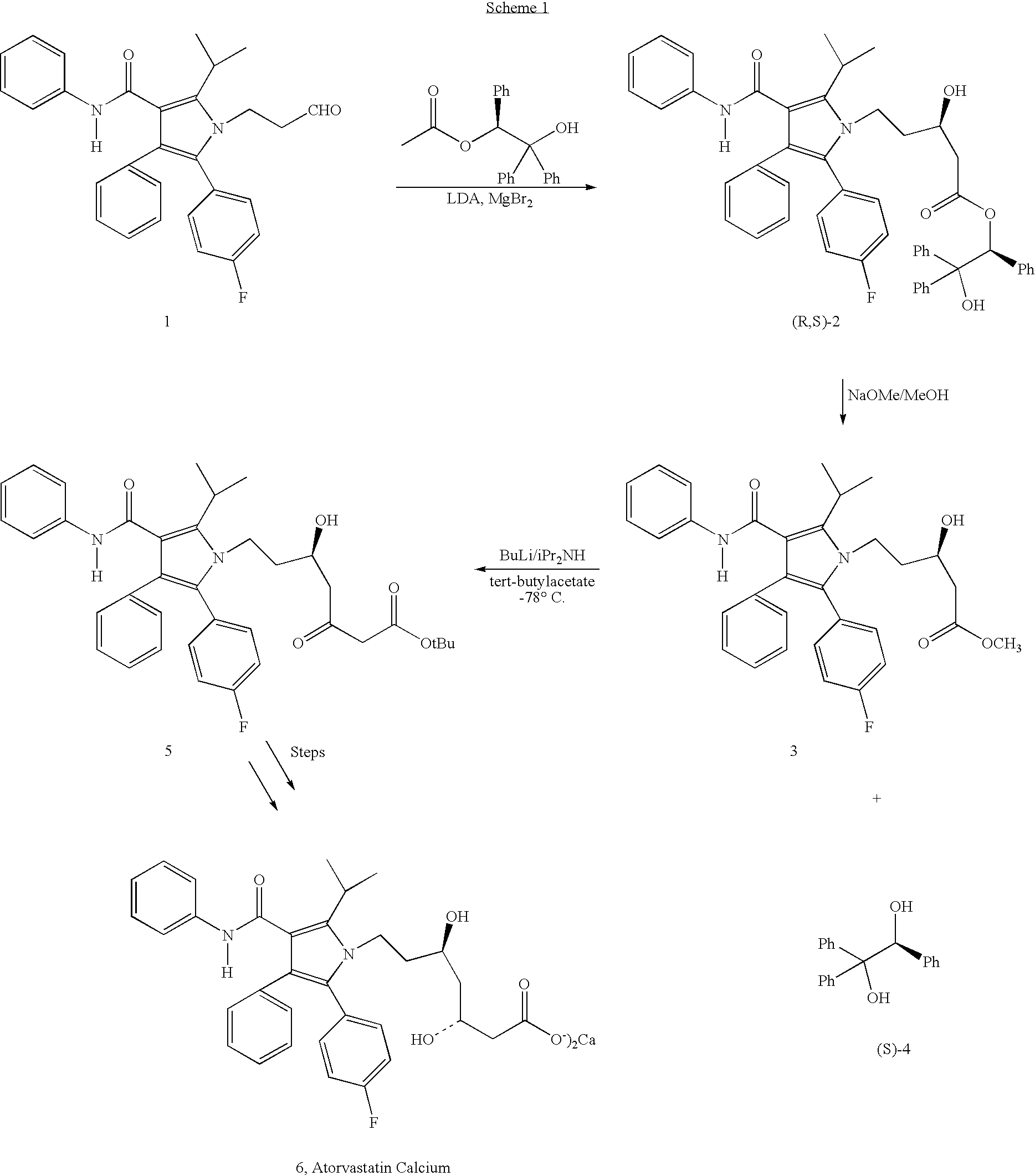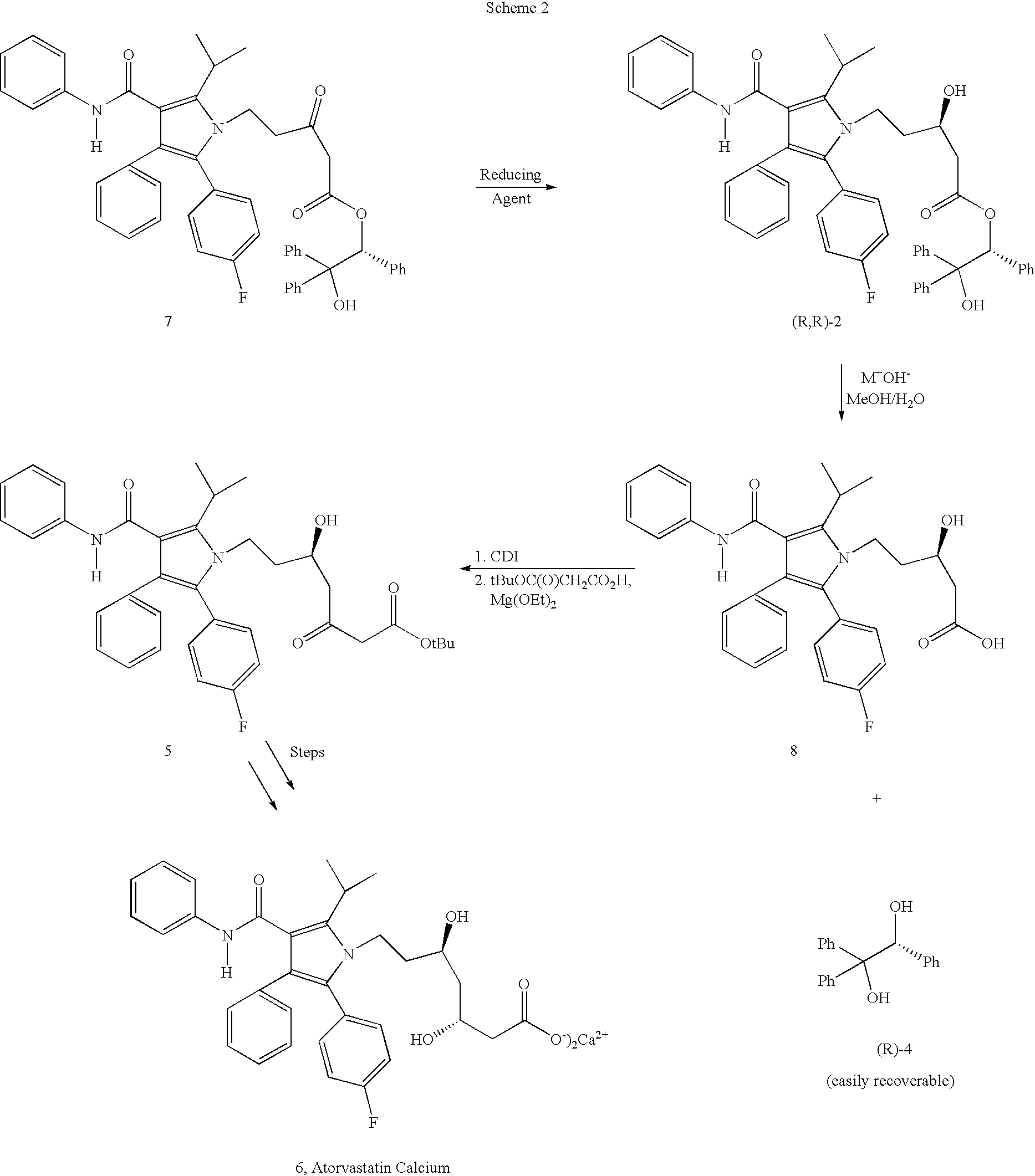Preparation of atorvastatin
a technology of atorvastatin and atorvastatin, which is applied in the field of atorvastatin preparation, can solve the problems of serious deficiencies in the route, and achieve the effects of easy drying, good handling properties, and easy isolability and stability
- Summary
- Abstract
- Description
- Claims
- Application Information
AI Technical Summary
Benefits of technology
Problems solved by technology
Method used
Image
Examples
example 1
Preparation of (R)-5-[2-(4-fluorophenyl)-5-(1-methylethyl)-3-phenyl-4-[(phenylamino)carbonyl]-1H-pyrrol-1-yl]-3-hydroxy-1-pentanoic acid, (R)-2-hydroxy-1,2,2-triphenylethyl ester (2)
[0037]A solution of 5-[2-(4-fluorophenyl)-5-(1-methylethyl)-3-phenyl-4-[(phenylamino)carbonyl]-1H-pyrrol-1-yl]-3-oxo-1-pentanoic acid, (R)-2-hydroxy-1,2,2-triphenylethyl ester (0.1 g, 0.127 mmol., 7) in 6 ml of THF / MeOH (1:2, v / v) was cooled to −78° C. To this solution was added sodium borohydride (20 mg) in two portions over a period of 0.5 h. The resulting reaction mixture was stirred at −78° C. for an additional 1 hour under nitrogen and then quenched with aqueous saturated NH4Cl solution and extracted with dichloromethane (10 mL×2). The combined dichloromethane layers were washed with brine (5 mL×2), dried (Na2SO4) and evaporated to give a white crystalline solid (0.94 g, 94%).
[0038]1H-NMR and HPLC analysis shows a mixture of two diastereomers in ratio 3:1(3R / 3S).
[0039]1H-NMR (300 MHz, CDCl3) (for th...
example 2
Preparation of (R)-5-[2-(4-Fluorophenyl)-5-(1-methylethyl)-3-phenyl-4-[(phenylamino)carbonyl]-1H-pyrrol-1-yl]-3-hydroxy-1-pentanoic acid (8)
[0040]To a suspension of (R)-5-[2-(4-fluorophenyl)-5-(1-methylethyl)-3-phenyl-4-[(phenylamino)carbonyl]-1H-pyrrol-1-yl]-3-hydroxy-1-pentanoic acid, (S)-2-hydroxy-1,2,2-triphenylethyl ester (7.9 g, 10 mmol.) in 144 mL of MeOH / H2O (3.5:1, v / v) was added potassium hydroxide (5.5 g, 100 mmol.). After refluxing for 4 hours, the mixture was cooled to room temperature whereupon 48 mL of water was added and the mixture was stirred a further 1-2 hours. The recovered (S)-1,1,2-triphenylethanediol was collected by filtration and washed with 30 mL of MeOH / H2O (1:3, v / v). The solid was dried under reduced pressure at 45–50° C. (2.7 g, 92%). The filtrate was evaporated to remove methanol and the pH was adjusted to 2–2.5 using a 1 M HCl solution. The resulting suspension was stirred at room temperature for 1–2 hours. The product was collected by Buchner filtra...
example 3
Preparation of (R)-5-[2-(4-Fluorophenyl)-5-(1-methylethyl)-3-phenyl-4-[(phenylamino)carbonyl]-1H-pyrrol-1-yl]-5-hydroxy-3-oxo-1-heptanoic acid, tert-butylester (5) from the acid (8)
[0044]1,1′-Carbonyldiimidazole (0.37 g) was added to a solution of the acid (8) (1.0 g) obtained from Example 2 in 10 mL THF. After stirring at room temperature for 3 hours, the magnesium salt prepared from reaction of magnesium ethoxide (0.58 g) and mono-tert-butyl malonate (1.7 g) was added. The mixture was stirred for 20 hours at room temperature and then the solvent was removed at reduced pressure. The residue was partitioned between ethyl acetate and aqueous 1 M HCl and the layers were separated. The aqueous phase was further extracted with ethyl acetate. The combined organic phases were washed with aqueous saturated NaHCO3 and brine. After drying and purifying, the P-ketoester 5 (0.5 g) was produced. The analytical data are consistent with the assigned structure.
PUM
| Property | Measurement | Unit |
|---|---|---|
| temperature | aaaaa | aaaaa |
| temperature | aaaaa | aaaaa |
| flammable | aaaaa | aaaaa |
Abstract
Description
Claims
Application Information
 Login to View More
Login to View More - R&D
- Intellectual Property
- Life Sciences
- Materials
- Tech Scout
- Unparalleled Data Quality
- Higher Quality Content
- 60% Fewer Hallucinations
Browse by: Latest US Patents, China's latest patents, Technical Efficacy Thesaurus, Application Domain, Technology Topic, Popular Technical Reports.
© 2025 PatSnap. All rights reserved.Legal|Privacy policy|Modern Slavery Act Transparency Statement|Sitemap|About US| Contact US: help@patsnap.com


